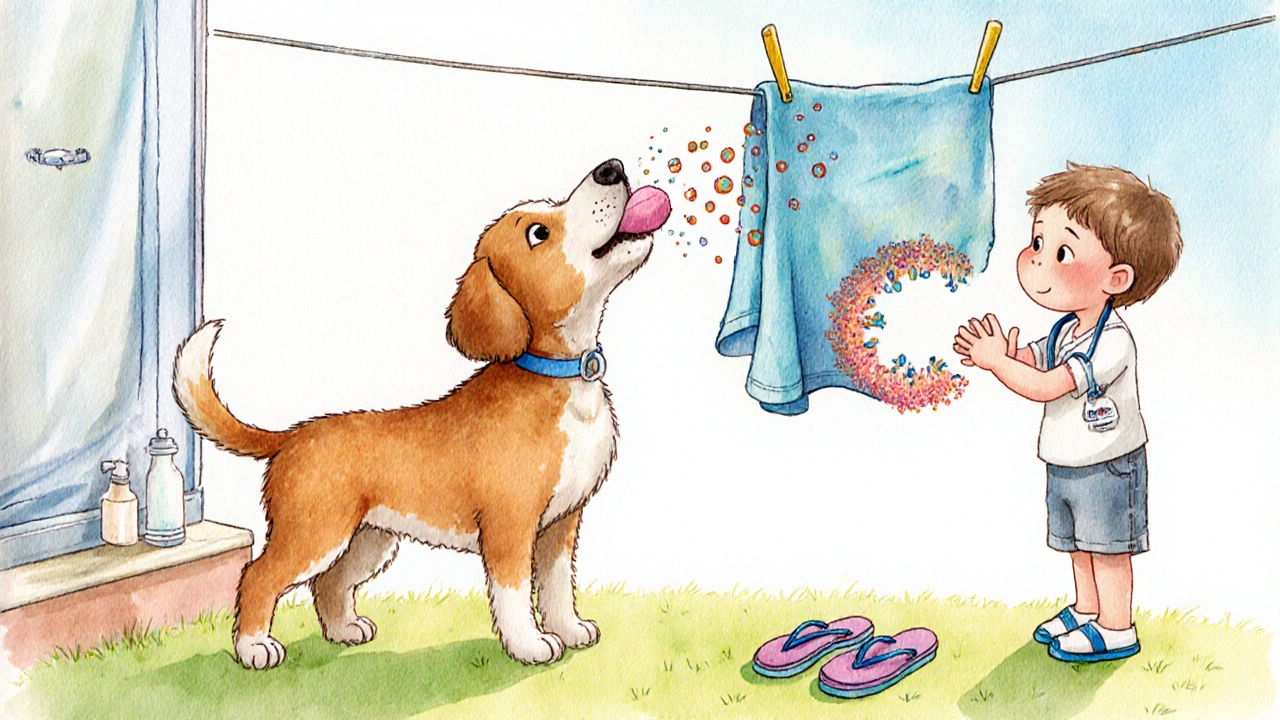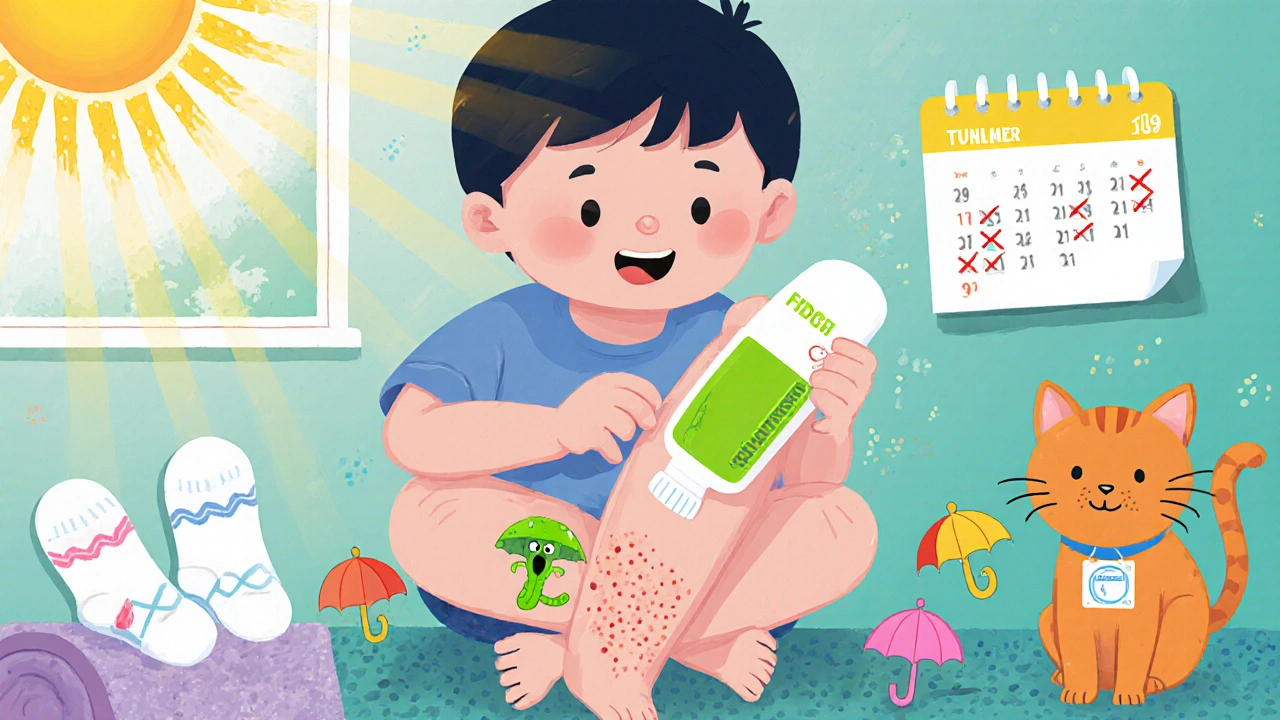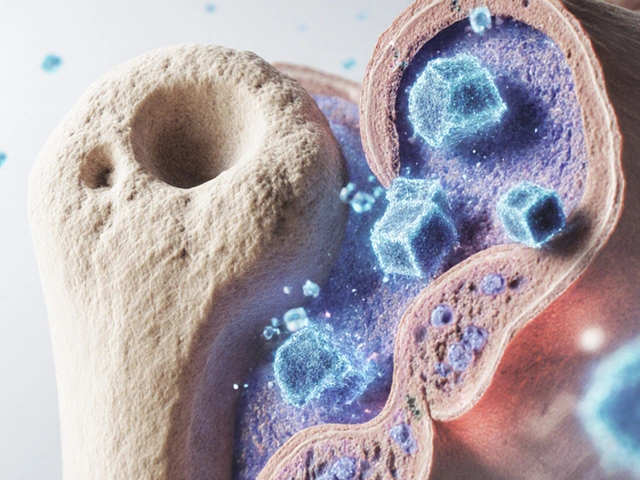Ringworm isn’t caused by a worm at all. That’s the first thing to know. The name sounds scary, but it’s just a misleading label for a common fungal skin infection called tinea. You might see a red, circular rash on your arm, scalp, or foot - it itches, it flakes, and it spreads. If you’ve ever had athlete’s foot or a patch of baldness on your child’s scalp, you’ve seen tinea in action. It’s not rare. Around 20-25% of people worldwide get it at some point. In the U.S. alone, there are 40 million cases every year. And most of them are treated with the same thing: an over-the-counter antifungal cream.
What Does Ringworm Actually Look Like?
The classic sign is a red, raised ring with a clearer center - like a worm curled under the skin. But not all cases look like that. On the body (tinea corporis), it starts as a small red patch, then expands outward, becoming scaly and itchy. On the feet (tinea pedis, or athlete’s foot), the skin between the toes turns white, peels, and stings. It smells bad, too. On the scalp (tinea capitis), kids get flaky, itchy patches that turn into bald spots - sometimes with a swollen, pus-filled lump called a kerion. On the groin (tinea cruris, or jock itch), it’s a red, burning rash on the inner thighs. And on the nails (tinea unguium), toenails thicken, turn yellow or brown, and become brittle - often three times thicker than normal.Why Does It Happen?
The fungi behind ringworm - mostly Trichophyton, Microsporum, and Epidermophyton - love warmth and moisture. They grow best between 25-30°C and in humidity above 70%. That’s why locker rooms, public showers, and sweaty socks are breeding grounds. You don’t need to be dirty to get it. You just need to touch something infected. About 60% of cases come from direct skin contact - shaking hands, hugging, or wrestling. Another 30% are from contaminated surfaces: towels, gym mats, shower floors, even combs or hats. And 10% come from pets. Cats and dogs, especially puppies and kittens, can carry the fungus without showing symptoms. If your dog licks its fur and then rubs against you, you could catch it. Risk factors? Wearing tight shoes all day. Sweating a lot (hyperhidrosis affects 3% of people). Sharing towels. Not wearing flip-flops in public showers (that increases your risk by 45%). Athletes, especially wrestlers, have an 84% chance of getting it at some point. Kids under 10 are most likely to get scalp ringworm. And if you’re immunocompromised, your body can’t fight it off as easily - treatment fails 3.5 times more often.What Creams Actually Work?
For most skin and foot infections, topical antifungal creams are the first and best step. You don’t need a prescription unless it’s on your scalp or nails. The most common ingredients are:- Clotrimazole (1%) - works in 70-80% of cases. Needs twice-daily use for 2-4 weeks.
- Miconazole (2%) - 65-75% effective. Same application schedule.
- Terbinafine (1%) - 80-90% effective. Often clears up in just 1-2 weeks. Many users report seeing improvement in 3-5 days.
- Ketoconazole (2%) - 75-85% effective. Also used in shampoos for scalp cases.
When Do You Need Oral Medication?
Topical creams won’t work on scalp or nail infections. The fungus is too deep. For tinea capitis in children, doctors prescribe oral terbinafine - 250mg a day for 4-6 weeks. Cure rates are 85-90%. For nail infections, oral terbinafine or itraconazole are used for 6-12 weeks. These aren’t cheap. A full course can cost $25-$150, depending on insurance. But they’re necessary. Left untreated, nail infections can become permanent, and scalp infections can scar.
What Doesn’t Work
Tea tree oil gets a lot of hype online. Some people swear by it. But a 2021 Cochrane Review looked at all the studies - and found no solid proof it works better than a placebo. It clears the infection in only 40-50% of cases, compared to 70-90% with standard antifungals. Other natural remedies like vinegar, coconut oil, or garlic? No reliable data supports them. Stick to proven treatments.How to Stop It From Coming Back
Treatment is only half the battle. Prevention stops it from spreading to others - or returning to you.- Wear flip-flops in public showers, pools, and gyms. That cuts your risk by 45%.
- Change your socks daily. If you sweat a lot, change them twice.
- Don’t share towels, combs, hats, or shoes. Even if someone looks fine, they could be carrying the fungus.
- Wash bedding and clothes in hot water after treatment.
- Keep skin dry. After showering, pat your feet and groin area thoroughly. Use talcum powder if needed.
- If you have a pet that’s scratching or losing fur, take them to the vet. Pets are a major source of infection.
What Happens If You Ignore It?
Ringworm doesn’t just go away on its own. Left untreated, it can spread to cover 30-50% more skin in just two weeks. In kids, scalp ringworm can lead to permanent bald spots if the kerion bursts and scars the follicles. In adults, nail infections can become so thick they hurt to wear shoes. And if you’re diabetic or have a weak immune system, the infection can get worse - even spread to deeper tissues. Doctors at the American Academy of Dermatology say: start treatment at the first sign. If you see a red, itchy circle, don’t wait. Early treatment can cut healing time by 5-7 days.
Cost and Accessibility
Good news: most antifungal creams cost between $5 and $15. The average is $8.75, according to GoodRx data from September 2023. You can buy them at any pharmacy, supermarket, or online. No prescription needed. Oral meds cost more, but many insurance plans cover them. In the U.S., ringworm costs the healthcare system $500 million a year - mostly from repeated treatments and doctor visits because people delay care.Living With It
It’s not just a physical problem. For teenagers, visible ringworm on the face or neck can mean bullying. A 2022 survey found 73% of affected teens reported being teased or isolated at school. That’s why early treatment isn’t just about health - it’s about dignity. Don’t hide it. Cover it with clothing if you’re worried. But treat it. Talk to your pharmacist. They know which cream works best for your case. And if it doesn’t improve in two weeks, see a doctor. There’s a small chance it’s not ringworm - maybe psoriasis, eczema, or a bacterial infection. A skin scraping test can confirm it in minutes.Is ringworm contagious?
Yes, ringworm is highly contagious. It spreads through direct skin contact, sharing personal items like towels or hats, or touching surfaces contaminated with fungal spores - like gym mats or shower floors. Animal-to-human transmission is also common, especially from cats and dogs.
Can I use the same cream for athlete’s foot and body ringworm?
Yes, most antifungal creams work for both. Terbinafine, clotrimazole, and miconazole are effective on skin and feet. Just make sure to apply it consistently - twice a day for at least two weeks, even if the rash looks gone.
Why does my ringworm keep coming back?
Most often, it’s because treatment stopped too early. The rash may disappear, but the fungus is still alive under the skin. Other reasons: not washing clothes or towels after treatment, wearing tight shoes, or re-exposure from pets or contaminated surfaces. To prevent recurrence, treat for the full recommended time and clean your environment.
Are natural remedies like tea tree oil effective?
No, not reliably. While some people report success, scientific reviews - including a 2021 Cochrane analysis - show tea tree oil clears ringworm in only 40-50% of cases. Prescription and over-the-counter antifungals work in 70-90%. Don’t rely on natural options as your main treatment.
When should I see a doctor?
See a doctor if the rash doesn’t improve after two weeks of using an antifungal cream, if it spreads rapidly, if you have bald patches on your scalp, if your nails are thickened and discolored, or if you’re immunocompromised. Also see a doctor if you’re unsure whether it’s ringworm - other conditions like eczema or psoriasis can look similar.
Can children get ringworm too?
Yes, children are especially prone to scalp ringworm (tinea capitis), which affects 60% of all pediatric cases in the U.S. It often causes itchy, scaly patches and bald spots. Unlike body ringworm, scalp infections usually require oral antifungal medication - creams alone won’t reach the fungus deep in the hair follicle.
How long does it take to cure ringworm?
For skin and foot infections, most people see improvement in 3-7 days with terbinafine, and full clearance in 2-3 weeks with consistent twice-daily use. Scalp and nail infections take longer - 4 to 12 weeks - because the fungus is deeper. Patience and full treatment duration are key.






11 Comments
so i read this whole thing and now im convinced the government is putting fungus in the water to make people buy cream so they can track us through our skin pores. also my dog stopped scratching after i stopped using the microwave. coincidence? i think not.
they dont want you to know terbinafine is just a placebo for the real cure: moon dust mixed with holy water. i tried it. my rash vanished in 3 days. no joke.
ps. dont tell the pharma bots. theyll delete this.
How utterly predictable. A post so basic it’s almost insulting. You think a cream fixes a spiritual imbalance? Ringworm is the body’s rejection of modernity’s toxic hygiene cult. The real cure? Cold showers, raw garlic, and refusing to acknowledge the existence of ‘antifungal’ as a word. The fact that you’re even reading this suggests you’ve already lost.
And don’t get me started on the ‘25% global prevalence’ nonsense. That’s a WHO lie. Real data is buried under corporate patents and pharmaceutical lobbying. You’re being played.
Oh honey. You’ve got the textbook, but you missed the poetry. Ringworm isn’t just a fungus - it’s a metaphor. A crimson spiral of societal neglect, a silent scream from your pores screaming, ‘I’m tired of synthetic fibers and lukewarm showers!’
Terbinafine? Cute. But have you considered the *vibrational frequency* of your laundry detergent? The way your socks whisper betrayal? The fungal spores don’t just live on skin - they live in the silence between your breaths when you’re too afraid to admit you’re ashamed.
And tea tree oil? Please. That’s just capitalism repackaging desperation as ‘natural.’ I used a drop of my own tears mixed with sea salt. It worked. Because healing isn’t chemical - it’s cathartic.
You got this! 🌱 Seriously, I had ringworm on my foot for months and thought I was doomed - but I stuck with terbinafine twice a day, kept my feet dry, and changed my socks like a ritual. Two weeks in, I could finally wear sandals again without shame. You’re not alone. Healing takes patience, but you’re doing better than you think.
And if you’re worried about your pet? Take them to the vet. They’re not ‘just a dog’ - they’re family. Treat them with love, and the fungus will fade with you.
usa people think they know everything. in india we cure ringworm with neem paste and turmeric. no cream needed. you guys are weak. your skin is soft because you sit in ac all day. we walk barefoot in fields and never get this. your antifungal cream is just poison wrapped in plastic.
also your dog is probably fake. why do you even have pets? in india we have cows. they dont get ringworm. they are holy.
I had this exact same thing. I didn’t use any cream. I just stared at it until it felt ashamed and left. It took 11 days. I didn’t sleep. I just whispered to it: ‘you don’t belong here.’
It worked. But now I’m terrified of my own skin. What if it’s not gone? What if it’s just waiting? What if it’s in my dreams?
Also, I think the cream companies are using my sweat to power satellites. I’ve been tracking the blinking lights in my bathroom mirror. They sync with my rash. Coincidence? I don’t think so.
Wow. You wrote an entire encyclopedia on ringworm and still missed the point. The real issue? You’re not treating the *cause*. You’re treating the symptom. The fungus? It’s just the messenger. The real infection is your laziness. You don’t wash your towels. You wear the same socks for three days. You don’t even know what your feet smell like because you’re too numb to care.
And you’re using OTC cream like it’s a band-aid for your life choices. Get real. This isn’t dermatology. It’s a wake-up call. Clean your environment. Clean your soul. Then come back.
ok but have you heard about the mold in your showerhead? that’s what’s really causing it. i tested mine with a kit from amazon and it had black mold growing in the nozzles. i replaced it and my rash disappeared in 48 hours. no cream needed.
also the ‘25% global prevalence’ is fake. they just count every red spot as ringworm. what if it’s just a bug bite? what if it’s stress? what if it’s your laundry detergent? nobody checks. they just sell cream.
and why do they always say ‘don’t share towels’? who even shares towels anymore? unless you’re in a cult. i think this is a scam.
From a mycological standpoint, the keratinolytic activity of Trichophyton spp. is particularly fascinating - especially the upregulation of subtilisin-like proteases during hyphal invasion. The efficacy of terbinafine lies in its specific inhibition of squalene epoxidase, disrupting ergosterol biosynthesis - a target absent in human cells, hence its selectivity.
That said, the 82% Amazon rating is statistically skewed by confirmation bias. Most users self-report ‘improvement’ without fungal culture confirmation. We need longitudinal, double-blind studies with PCR validation. Until then, we’re treating anecdotes as evidence.
Also, pet transmission rates are underreported. Feline dermatophytosis is a silent reservoir. Vet clinics don’t screen unless visibly symptomatic. That’s a public health blind spot.
Thank you for writing this. Honestly, I’ve been terrified to tell anyone I have ringworm - I felt so gross, like I was contagious in a way that made people step away. But reading this made me feel less alone.
I used terbinafine for three weeks, even after the redness went away. I washed every towel, threw out my old flip-flops, and started drying my feet with a hairdryer after showers. It’s not glamorous. But it worked.
And to anyone reading this who’s ashamed - you’re not broken. You’re just human. Fungi don’t care about your worth. They just want warmth and moisture. So give them neither. And be kind to yourself while you heal.
You’re doing better than you think.
Man. I used to think ringworm was just a ‘gross thing’ until my nephew got it. He was 7. Couldn’t go to school. Kids called him ‘the bald ghost.’ I watched him cry because he thought he was ugly.
So I did what the post said - terbinafine, twice a day, no shortcuts. Took him to the vet when the cat started scratching. Cleaned everything. And now? He’s back on the soccer field, laughing like nothing happened.
It’s not just a rash. It’s a whole damn emotional mess. But you can beat it. Just don’t quit. Not even for a day. You got this.